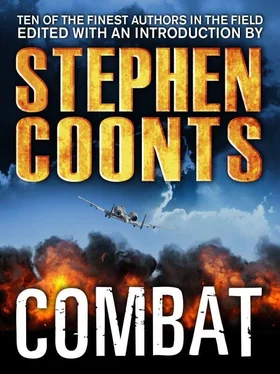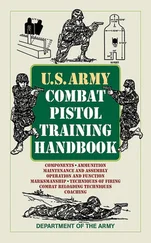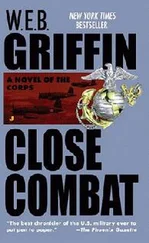Patrick turned back to her. “Yes, Doctor?”
“You never told me.”
“Told you what?”
“Do all my systems look OK to you?”
Thank God she smiled after that, Patrick thought — maybe she doesn’t think I’m some sort of pervert. Regaining a bit of his lost composure, but still afraid to let his eyes roam over her “systems,” he replied, “They look great to me, Doc.”
“Good,” she said. “Thank you.” She smiled a bit more warmly, let her eyes look him up and down, and added, “I’ll be sure to keep an eye on your systems too.”
Patrick never felt more relieved, and yet more naked, as he bent to crawl through that connecting tunnel and make his way to the cockpit. But just before he announced he was moving forward and unplugged his intercom cord, he heard the slow-paced electronic “DEEDLE … DEEDLE … DEEDLE …” warning tone of the ship’s threat-detection system. They had just been highlighted by enemy radar.
Patrick virtually flew back into his ejection seat, strapped in, and unsafed his ejection seat. He was in the aft crew compartment of an EB-52C Megafortress bomber, the next generation of “flying battleships” Patrick’s classified research unit was hoping to produce for the Air Force. It was once a “stock” B-52H Stratofortress bomber, the workhorse of America’s long-range heavy-bombardment fleet, built for long range and heavy nuclear and nonnuclear payloads. The original B-52 was designed in the 1950s; the last rolled off the assembly line twenty years ago. But this plane was different. The original airframe had been rebuilt from the ground up with state-of-the-art technology not just to modernize it, but to make it the most advanced warplane … that no one had ever heard of.
“Wendy?” he radioed on interphone. “What do we got?”
“This is weird,” Wendy responded. “I’ve got a variable PRF X-band target out there. Switching between antiship and antiaircraft search profiles. Estimated range … damn, range thirty-five miles, twelve o’clock. He’s right on top of us. Well within radar-guided missile range.”
“Any idea what it is?”
“Could be an AWACS plane,” Wendy replied. “He looks like he’s scanning both surface and air targets. No fast PRFs — just scanning. Faster than an APY scan, like on an E-2 Hawkeye or E-3 Sentry, but same profile.”
“An Iranian AWACS?” Patrick asked. The EB-52 Megafortress was flying in international airspace over the Gulf of Oman, just west of the Iranian coastline and just south of the Strait of Hormuz, outside the Persian Gulf. The director of the High Technology Aerospace Weapons Center, Lieutenant General Brad Elliott, had ordered three of his experimental Megafortress bombers to start patrolling the skies near the Persian Gulf to provide a secret, stealthy punch in case one of the supposedly neutral countries in the region decided to jump into the conflict raging between the Coalition forces and the Republic of Iraq.
“Could be a ‘Mainstay’ or ‘Candid,’” Patrick offered. “One of the aircraft Iraq supposedly surrendered to Iran was an Ilyushin-76MD airborne early-warning aircraft. Maybe the Iranians are trying out their new toy. Can he see us?”
“I think he can,” Wendy said. “He’s not locking on to us, just scanning around — but he’s close, and we’re approaching detection threshold.” The B-52 Stratofortress was not designed or ever considered a “stealth” aircraft, but the EB-52 Megafortress was much different. It retained most of the new antiradar technology it had been fitted with as an experimental test-bed aircraft — nonmetallic “fibersteel” skin, stronger and lighter than steel but nonradar-reflective; swept-back control surfaces instead of straight edges; no external antennas; radar-absorbent material used in the engine inlets and windows; and a unique radar-absorbing energy system that retransmitted radar energy along the airframe and discharged it back along the wing trailing edges, reducing the amount of radar energy reflected back to the enemy. It also carried a wide variety of weapons and could provide as much firepower as a flight of Air Force or Navy tactical fighters.
“Looks like he’s ‘guarding’ the Strait of Hormuz, looking for inbound aircraft,” Patrick offered. “Heading two-three-zero to go around him. If he spots us, it might get the Iranians excited.”
But he had spoken too late: “He can see us,” Wendy cut in. “He’s at thirty-five miles, one o’clock, high, making a beeline for us. Speed increasing to five hundred knots.”
“That’s not an AWACS plane,” Patrick said. “Looks like we picked up some kind of fast-moving patrol plane.”
“Crap,” the aircraft commander, Lieutenant General Brad Elliott, swore on intercom. Elliott was the commander of the High Technology Aerospace Weapons Center, also known as Dreamland, and the developer of the EB-52 Megafortress flying battleship. “Shut his radar down, Wendy, and let’s hope he thinks he has a bent radar and decides to call it a night.”
“Let’s get out of here, Brad,” Patrick chimed in. “No sense in risking a dogfight up here.”
“We’re in international airspace,” Elliott retorted indignantly. “We have as much right to be up here as this turkey.”
“Sir, this is a combat area,” Patrick emphasized. “Crew, let’s get ready to get the hell out of here.”
With one touch, Wendy ordered the Megafortress’s powerful jammers to shut down the Iranian fighter’s search radar. “Trackbreakers active,” Wendy announced. “Give me ninety left.” Brad Elliott put the Megafortress in a tight right turn and rolled out perpendicular to the fighter’s flight path. The plane’s pulse-Doppler radar might not detect a target with a zero relative closure rate. “Bandit at three o‘clock, thirty-five miles and steady, high. Moving to four o’clock. I think he lost us.”
“Not so fast,” the crew mission commander and copilot, Colonel John Ormack, interjected. Ormack was HAWC’s deputy commander and chief engineering wizard, a commander pilot with several thousand hours in various tactical aircraft. But his first love was computers, avionics, and gadgets. Brad Elliott had the ideas, but he relied on Ormack to turn those ideas into reality. If they gave badges or wings for technogeeks, John Ormack would wear them proudly. “He might be going passive. We’ve got to put some distance between us and him. He might not need a radar to intercept us.”
“I copy that,” Wendy said. “But I think his IRSTS is out of range. He …”
At that moment, they all heard a loud, faster-paced “DEEDLE DEEDLE DEEDLE!” warning on the intercom. “Airborne interceptor locked on, range thirty miles and closing fast! His radar is huge — he’s burning right through my jammers. Solid radar lock, closure rate … closure rate moving to six hundred knots !”
“Well,” John Ormack said, “at least that water down there is warm even this time of year.”
Making jokes was the only thing any of them could think about right then — because being highlighted by a supersonic interceptor alone over the Gulf of Oman was just about the most fatal thing a bomber crew could ever face.
* * *
This morning was a little different for Norman Weir. Today and for the next two weeks Weir and several dozen of his fellow Air Force full colonels were at Randolph Air Force Base near San Antonio, Texas, for a lieutenant colonel’s promotion board. Their task: pick the best, the brightest, and the most highly qualified from a field of about three thousand Air Force majors to be promoted to lieutenant colonel.
Colonel Norman Weir knew a lot about making choices using complex objective criteria — a promotion board was right up his alley. Norman was commander of the Air Force Budget Analysis Agency at the Pentagon. His job was to do exactly what he was now being asked to do: sift through mountains of information on weapon and information systems and decide the future life-cycle costs and benefits of each. In effect, he and his staff of sixty-five military and civilian analysts, accountants, and technical experts decided the future of the United States Air Force every day. Every aircraft, missile, satellite, computer, “black box,” and bomb, along with every man and woman in the Air Force, came under his scrutiny. Every item on every unit’s budget had to pass his team’s rigorous examination. If it didn’t, by the end of the fiscal year it would cease to exist with a single memo to someone in the Secretary of the Air Force’s office. He had power and responsibility over billions of dollars every week, and he wielded that power with skill and enthusiasm.
Читать дальше












